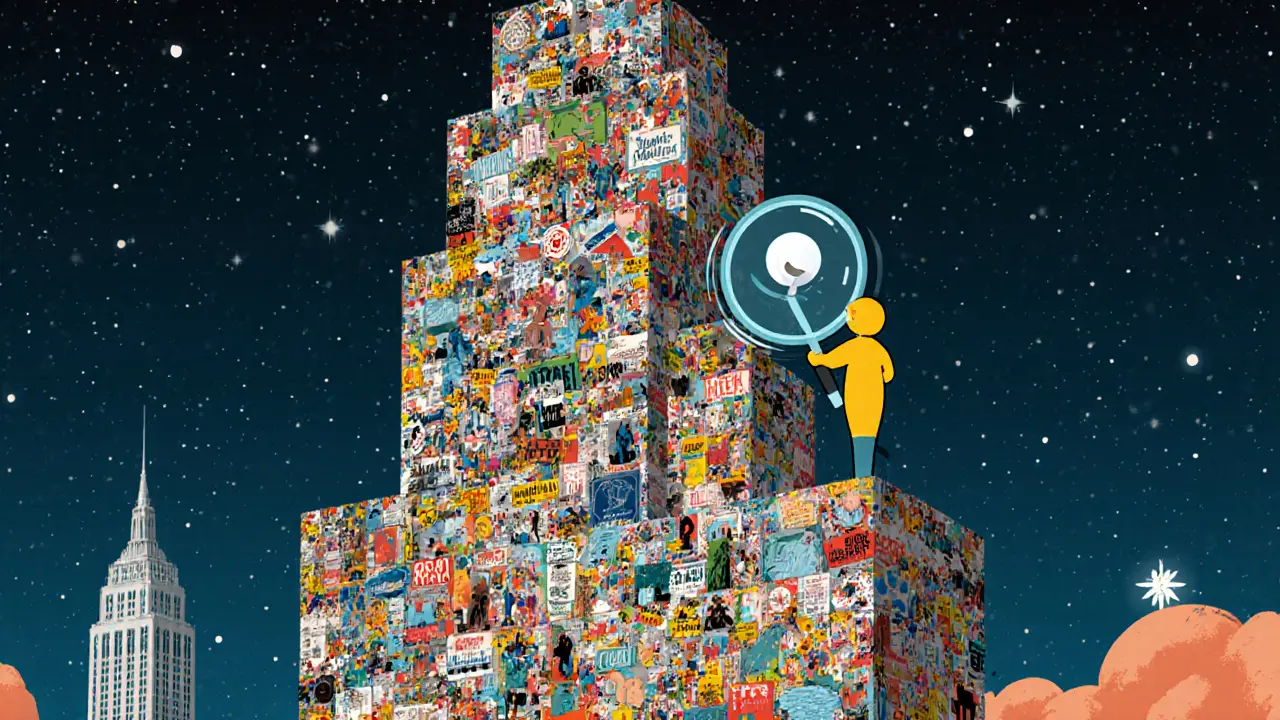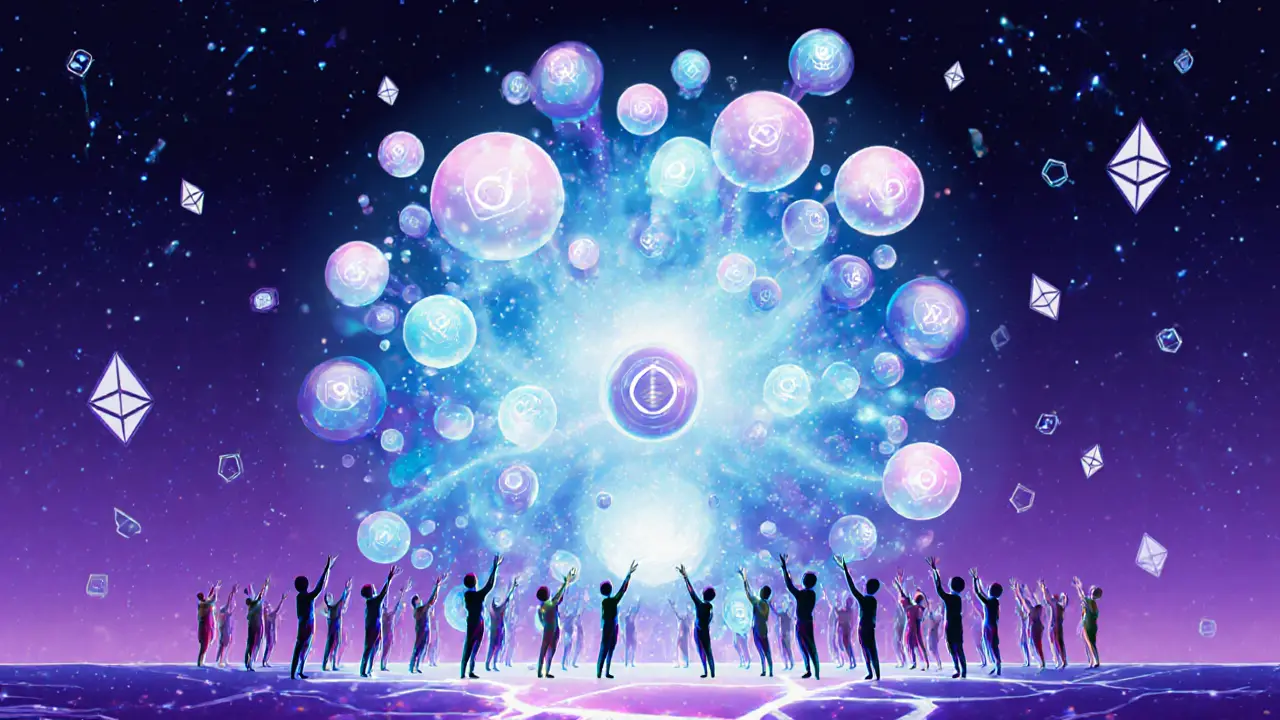NFT Value Comparison Calculator
Understand the Value of Record-Breaking NFTs
See what $91.8 million (The Merge) or $69.3 million (Beeple) could buy in today's world. Compare to real-world equivalents like salaries, real estate, and even CryptoPunk values.
Equivalent Values
The highest price ever paid for a digital artwork isn't on a museum wall - it's locked in a blockchain. In December 2021, a single NFT called The Merge sold for $91.8 million, making it the most expensive NFT ever sold. But here’s the twist: it wasn’t bought by one person. It was bought by 28,893 people - each owning a piece of it. This wasn’t just a sale. It was a collective experiment in ownership, and it changed how we think about digital art forever.
How The Merge Broke the Record
The Merge was created by the anonymous artist Murat Pak. Unlike traditional NFTs, which are single, static files, The Merge was made up of 295,417 individual units called “mass.” Buyers could purchase as many as they wanted during a 48-hour window. The more mass units someone owned, the more their piece changed visually. When two people bought mass units, those units could combine into one larger unit. The final artwork’s appearance depended entirely on how many units were bought and merged. It wasn’t just art - it was a live, evolving system built on Ethereum smart contracts.The sale raised $91.8 million in ETH, making it the most valuable NFT transaction in history. Even though it was a fractional purchase, the entire artwork is treated as one NFT because it shares the same smart contract and visual identity. Critics argue whether fractional sales should count as a single NFT sale, but the market accepted it. Today, The Merge still holds the top spot - and no other NFT has come close.
Beeple’s $69.3 Million Masterpiece
Before The Merge, the record belonged to Beeple - the digital artist Mike Winkelmann. His piece, Everydays: The First 5000 Days, sold for $69.3 million at Christie’s in March 2021. This wasn’t just any digital collage. It was 5,000 individual images, one made every day for 13 years, starting on May 1, 2007. Each image captured something: a political scandal, a viral meme, a personal moment, or a dystopian fantasy. Together, they formed a visual diary of the modern internet age.The buyer was Vignesh Sundaresan, also known as MetaKovan, a Singapore-based investor who made headlines when he said he bought it to prove digital art mattered. This sale was historic for another reason: it was the first time Christie’s, one of the world’s oldest and most respected auction houses, sold an NFT. Suddenly, NFTs weren’t just for crypto bros - they were entering the mainstream art world.

CryptoPunks: The OG Digital Collectibles
While The Merge and Everydays were single masterpieces, CryptoPunks were the foundation of the entire NFT boom. Created in 2017 by Larva Labs, CryptoPunks are 10,000 unique pixel-art characters. Only 9 are Aliens, 24 are Apes, and 88 are Zombies - the rest are mostly humans with hats, beards, or bandanas. Rarity drives value. CryptoPunk #5822, an Alien with a bandana and a pipe, sold for $23.7 million in May 2021. Another, #4156, an Ape with a beanie, went for $10.26 million.These aren’t just pictures. They’re digital heirlooms. Early adopters bought them for less than $1 each. Now, owning one is a status symbol in the crypto world. Celebrities, investors, and tech founders display them as profile pictures. The rarity of certain traits - like an Alien or Ape - keeps prices high even after the 2022 market crash. CryptoPunks are still traded on OpenSea and Larva Labs’ own platform, with floor prices hovering around $70,000 to $100,000 for common types, and millions for the rarest.
Other Record-Breaking NFTs
The top five most expensive NFTs include two more from Beeple. HUMAN ONE, a rotating digital sculpture of a figure in a spacesuit, sold for $28.95 million in November 2021. The buyer, Ryan Zurrer, is a venture capitalist deeply involved in Web3. He didn’t just want art - he wanted a symbol of the future.Then there’s Clock, a collaboration between Murat Pak and Julian Assange. It’s a live-updating timer showing how long Assange has been imprisoned. It sold for $52.7 million in February 2022. The artwork changes every second, and ownership is tied to a public statement about freedom and digital resistance.
On the Tron blockchain, Justin Sun bought TPunk #3442 - a copycat version of CryptoPunk - for $10.5 million. He reportedly made the purchase after losing a bid for Beeple’s Everydays by just $250,000. It was a statement: even a derivative can be worth millions if you’re determined enough.
On Art Blocks, a platform for generative art, Ringers #109 by Dmitri Cherniak sold for $6.93 million. The artwork is created by code - strings and pegs that twist into abstract patterns. Each piece is unique, and even the cheapest Ringer now costs over $88,000. Art Blocks NFTs are special because the entire artwork code lives on the blockchain, not just a link to an image.
Why These NFTs Cost So Much
It’s easy to look at these prices and think they’re insane. But there’s a logic behind them. The most expensive NFTs combine rarity, cultural relevance, and historical timing. CryptoPunks are the first NFT collection. Beeple’s work is a 13-year daily commitment. The Merge redefined ownership. These aren’t just JPEGs - they’re artifacts of a digital revolution.Most of these sales happened in 2021 and early 2022, when crypto markets were soaring and speculation was rampant. Ethereum gas fees hit $300 per transaction. People were buying NFTs like they were stocks during the dot-com boom. Since then, the market has cooled. Many NFTs are worth a fraction of their peak. But the top few? They’ve held up. Why? Because they’re not just collectibles - they’re landmarks.
Think of them like the Mona Lisa. No one expects to own it. But everyone knows its value. CryptoPunk #5822 isn’t just a pixel art punk. It’s the first NFT to cross $20 million. The Merge isn’t just a digital painting. It’s proof that thousands of people can co-own a single piece of art - and still see it as valuable.
What Happens Now?
The NFT market isn’t what it was in 2021. Prices are lower. New projects struggle to gain traction. But the most expensive NFTs? They’re still trading. CryptoPunks still sell for millions. The Merge remains untouchable. Collectors aren’t just buying art - they’re buying a piece of history.Artists like Beeple and Murat Pak have moved on to new projects. But their legacy is locked in the blockchain. Even if the next big thing comes along, these NFTs will be remembered as the ones that changed everything. They proved digital art could be worth more than physical art. They proved blockchain could be more than just cryptocurrency. And they proved that, sometimes, a JPEG can be priceless.
What is the most expensive NFT ever sold?
The most expensive NFT ever sold is "The Merge" by Murat Pak, which sold for $91.8 million in December 2021. It was purchased by 28,893 individual buyers who each bought one or more "mass" units. The artwork changes visually based on how many units are owned and merged, making it a dynamic, community-driven piece.
Who bought Beeple’s "Everydays: The First 5000 Days"?
Vignesh Sundaresan, also known as MetaKovan, bought Beeple’s "Everydays: The First 5000 Days" for $69.3 million at Christie’s in March 2021. He’s a Singapore-based investor who stated the purchase was meant to show the world that digital art matters. This sale marked the first time Christie’s auctioned an NFT.
Why are CryptoPunks so valuable?
CryptoPunks are valuable because they were the first NFT collection, released in 2017. Only 10,000 exist, and some have rare traits - like Alien (only 9), Ape (only 24), or Zombie (only 88). Their historical significance, scarcity, and status as early digital collectibles make them highly sought after. Even after market crashes, the rarest punks still sell for millions.
Can you still buy The Merge today?
No, you cannot buy "The Merge" as a single NFT anymore. It was sold as 295,417 individual mass units during a 48-hour sale in 2021. Each unit is now owned by a different person. The entire artwork exists as one unified piece on the blockchain, but ownership is distributed. You can buy individual mass units on secondary markets, but they won’t give you full ownership of the entire artwork.
Are NFT prices still this high today?
No. Most NFTs have dropped significantly in value since the 2021-2022 peak. Many collections are trading at 80-95% below their highs. However, the top-tier NFTs - like CryptoPunks, Beeple’s works, and Art Blocks generative art - have held their value much better. The most expensive NFTs are now seen as digital collectibles with historical importance, not just speculative assets.
What blockchain are the most expensive NFTs on?
The most expensive NFTs are almost all on the Ethereum blockchain. This includes "The Merge," Beeple’s pieces, CryptoPunks, and Ringers. Ethereum was the dominant platform for NFTs during the 2021 boom because of its smart contract capabilities and early adoption. A few, like TPunk, were sold on Tron, but these are exceptions and often considered derivatives.
What makes an NFT valuable?
An NFT’s value comes from a mix of rarity, creator reputation, historical significance, and community demand. The most valuable NFTs are often firsts - the first digital art auction, the first NFT collection, the first piece to use a new technology. Ownership records on the blockchain add authenticity, but it’s cultural weight that drives price. A JPEG with no context is worth nothing. A JPEG tied to a major moment in digital history? That’s priceless.
Is The Merge really one NFT if 28,893 people own parts of it?
Yes. Technically, "The Merge" is one NFT defined by a single smart contract on Ethereum. The 295,417 mass units are like shares in that single asset. Each unit can be traded separately, but they all contribute to the same visual output. The artwork evolves as more units are bought and merged. So while ownership is distributed, the artwork itself remains unified. This structure was intentional - it was designed to challenge the idea that art must be owned by one person.
